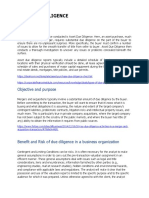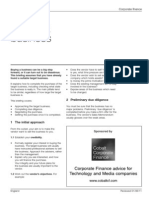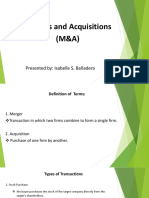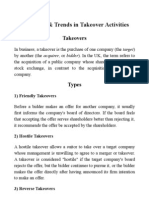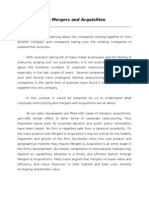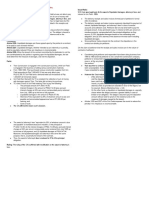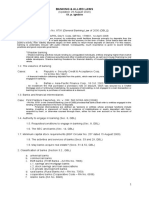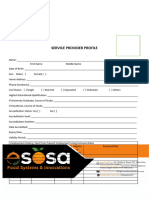BUCAS GRANDE FOUNDATION COLLEGE
Taruc, Socorro, Surigao del Norte
Lecture Notes
in
ELEC 12
MERGER AND ACQUISITION
(Bachelor of Science in Entrepreneurship)
1ST Semester, AY 2022-2023
Prepared by:
Jackylou Hingpit Canta
Instructor
1
� TABLE OF CONTENTS
Chapter 3 Topics Pages
Early Stages ------------------------------------------------------------------------- 3
Target Analysis and Evaluation --------------------------------------------------- 4
Reaching Agreement --------------------------------------------------------------- 4
The Exclusivity Agreement -------------------------------------------------------- 5
Due Diligence ------------------------------------------------------------------------ 5
Sale and Purchase Agreement ---------------------------------------------------- 8
Warranties and Indemnities ------------------------------------------------------- 9
Conditions precedent and subsequent ------------------------------------------ 10
Completion -------------------------------------------------------------------------- 10
After Completion -------------------------------------------------------------------- 11
CHAPTER 3 Private Company Acquisitions: A Process Overview
An overview of the acquisition process is shown in the following diagram.
2
� Figure 1: M&A Process Overview
Early Stages
The start of any acquisition process is the identification and analysis of
targets. It’s critical at this early stage to understand the deal motivation, and set
clear acquisition criteria.
The first question for management is: Why are we looking for acquisitions? Is
this to acquire access to a particular market; to reduce exposure to a particular
customer or market; to improve a competitive position? Whatever the rationale it
must be clearly agreed, expressed and communicated to the deal team, including
financial and legal advisers.
Following on from this, the acquirer should set clear criteria for suitable
targets, being as specific as possible. Most acquirers will have a clear understanding
of the minimum size of business they need and the maximum possible purchase
consideration; but there are many other factors to consider; for example, are they
looking for businesses with strong incumbent management, or are they happy with
retirement situations? Is there a requirement for specific technology, location,
market focus, profitability levels?
Identifying targets may be done in-house, if the acquirer has enough
resources, or it can be done by its advisors. Larger companies will often be
approached by the origination teams of investment banks, with proactively identified
potential deal opportunities. The identification will involve researching potential
targets from a range of sources including databases and their own industry
knowledge and contacts. At this early stage, there is only limited information
available in the public domain about private company targets, such as annual filings,
news reports and market surveys, and these should be used for initial analysis and
short listing.
The approach to potential targets may be done either by advisors or by the
acquirer, depending on the level of confidentiality required. Any approach should be
made to the CEO of the parent company; if it is private equity backed, then the
approach should be made to the owner.
Target Analysis and Evaluation
If the approach meets with a positive response, then the next stage is
generally to meet, request additional information and sign a NDA (non-disclosure
agreement, also called a confidentiality undertaking).
The NDA is legally binding agreement, in this case signed by the potential
acquirer, confirming that any non-public information provided in relation to the
target will be safeguarded, not disclosed to any other party, and not used for any
purpose other than that of considering the potential purchase of the target.
3
� What information should the acquirer seek at this stage? It varies of course
from company to company, but sample request list would include:
Latest financial statements
Management account for the year to date, with commentary
Current year budgets and long-term forecasts
Information of the management and employees
Recent real estate valuations, if any
Key customers and current order book
The aim at this stage is, firstly, to ensure that the target does in fact meet the
acquirer’s acquisition criteria, but also – and critically – to provide enough
information to allow the acquirer to establish a reasonable offer price.
The valuation is likely to be centered on a DCF (discounted cash flow)
analysis. The inputs for this are the information of capital structure, capital
expenditure and cash flow forecasts for at least four to five years. It may also
include comparable company analysis - identifying the valuation metrics for similar
quoted companies or past transactions, and applying them to target’s profit
forecasts to derive a value.
In the case of heavily asset-based businesses or loss-making companies, the
valuation will be more focused on the target’s asset and liability position.
Reaching Agreement
Once a price has been proposed and negotiated, the next stage is the
agreement of a Letter of Intent. This may also be referred to as Heads of Terms,
Heads of Agreement or Memorandum of Understanding.
The Letter of Intent is a document setting out the headline terms of the
agreement reached, including price, deal structure and any key conditions. It is
signed by acquirer and vendor but – with the exception of certain provisions – is not
intended to be legally binding and is not a contract.
The purpose of LoI is:
To ensure that all of the key points of the proposed transaction are set out
clearly and agreed by both parties and that no area for potential dispute
remains.
To provide clarity on the key terms of transaction for the lawyers who must
draft the final contract
To provide framework for continued negotiation, by including
o Provision on the scope and timing of due diligence to be carried out
o Confirmation of the confidentiality obligations of each side of the
transaction
o Provision for the exclusivity
4
�The Exclusivity Agreement
Exclusivity agreements bind the vendor to negotiate exclusively with one
particular purchaser and not enter or continue discussions with rival bidders, for a
period of time.
Once the LoI is signed, the acquirer must incur extensive legal, accounting
and advisory expense before completing the deal. He is therefore keen to ensure
that the vendor is committed to continuing to progress the deal, and will not look for
higher bidders. For this reason, the parties frequently enter into an exclusivity
agreement whereby the vendor agrees not to look for alternative purchasers, to
terminate any existing discussions with other purchasers and, in some cases, to
refuse to enter into discussions even if approached by an unsolicited alternative
purchaser. This agreement is contractually binding.
The penalty for the vendor’s breach of the exclusivity agreement forms part
of the agreement. It might be pre-agreed damages (which is common in the USA);
there might be a penalty based on a percentage of the agreed transaction price; or,
in many countries, it may simply be a requirement for the vendor to reimburse the
original acquirer’s expenses incurred, such as legal and due diligence costs.
Due Diligence
Due diligence is a detailed investigation into a company’s past history, current
status and future prospects. Generally, the vendor and advisors assemble a data
room – either physical or virtual – where the relevant data to be reviewed is stored.
The due diligence teams have access to the data room for checking and analysis of
the data for a period of time, and they then prepare a detailed report on their
findings, to provide the acquirer.
In addition, when goods or services are bought by a consumer certain
conditions are implied by law, for example, that the goods will be of satisfactory
quality and fit for purpose. When a buyer acquires the shares or business of a
company no such conditions are implied and the general principle “buyer beware”
applies. A buyer will want to gather as much information about the company or
business as possible to understand what it is taking on – as a process this is known
as “carrying out due diligence”.
The scope and level of detail of the due diligence is negotiated between the
vendor and the acquirer, and will vary from deal to deal and industry to industry.
However the following are some most common areas for investigation.
1. Financial due diligence
The buyer’s accountants will analyses the financial books of the Target
Company or business and back up this paper review by talking to its
accountants and management. Financial due diligence will focus on assessing
the historic trading performance of the company or business to check that the
5
� assumptions the buyer is making about its future are supported. This can be
carried out by the accounting team; a non-exhaustive list would include:
Analysis of the company’s historic financial statements, including
the accounting policies such as provisions and depreciation;
Analysis of budgets and forecasts against assumptions and
trading-to-date, including a review of historic actual-to-budget
performance;
Analysis of internal financial controls and processes, and internal
audit if any;
Asset review, including inventory checks, receivables analysis
and checking existence of major non-current assets;
Capital and indebtedness review, including confirmi9ng current
level of debt and liquidity and the repayment and interest
obligations;
Working capital review, confirming the sources of working
capital and its availability for the near team;
Cash flow analysis, including operational, financing and
investment cash flow and requirements.
2. Legal due diligence
Traditionally the buyer’s lawyers send a detailed information request to
the sellers or their lawyers, designed to flush out as much useful information
as possible. These enquiries usually cover all aspects of the Target Company
or business being acquired. Where a company is being acquired this will
include everything from its constitution to its employees, contracts, licenses,
property, financing arrangements, intellectual property rights and IT systems.
The degree of focus on any particular area will depend on the nature of the
target business or company, where the buyer perceives the risks lie or what it
considers the target’s “crown jewels” to be. This can be carried out by the
legal team including:
Checking the target’s incorporation documents;
Checking the existence and the robustness of key contracts,
including employment, customer and supply contracts and lease
agreements;
Reviewing any litigation or potential litigation;
Compliance reviews, including health and safety, regulatory
compliance (such as financial services) and anti-trust;
Checking the title of tangible fixed assets;
Confirming patent, trademark and other intellectual property
rights.
Legal due diligence can be a lengthy and sometimes frustrating
process, particularly for sellers who will invariably need to commit significant
time and resources responding to the buyer’s enquiries. Whilst it is started
early on in negotiations, it can often continue well into the deal process and
overlap with the disclosure process.
3. Other key areas for due diligence
6
� Each carried out by separate specialists, including:
a. Taxation – ensuring tax filings are complete and up to date, and
confirming potential additional liabilities.
b. Pensions – valuing any defined benefit scheme, quantifying
liabilities, checking legal
c. Real estate – valuations of property and repair/maintenance
schedules, confirmation of lease obligations
d. Environmental – sample of testing of air, water and/or land if
required to check for contamination and quantify liability
e. Information technology – checking that system are robust and up-
to-date and maintenance contracts and warranties are in place
f. Insurance – confirming that insurance has been and still is in place
in all key areas for the period under review
g. Management – checking the qualifications and employment record
of key management members. In private equity backed deals this is
very major and detailed part of the due diligence process.
Due diligence is a critical part of the M&A process. If there are adverse
findings at any stage, the acquirer must decide how far they will affect deal,
and what action to take. If these findings compromise the underlying logic of
the acquisition, the acquirer may pull out of discussions completely;
otherwise, he may decide to renegotiate the price or deal structure, or impose
additional conditions or terms.
Once due diligence is completed and any changes to the deal have
been negotiated, the next stage is to proceed to contract.
Sale and Purchase Agreement
The Sale and Purchase Agreement is a contract between acquirer and
the vendor for the sale and purchase of the target.
The central document in the acquisition of a private company is a
legally binding contract, entered into between the acquirer and the vendor.
This is referred to as the Sale and Purchase Agreement or SPA.
The SPA is a lengthy document, consisting of the following main items:
1. Key definitions and legal jurisdiction
What exactly is being bought and sold? Does the contract
operate under UK or French law?
2. Summary of the main terms of agreement
In overview, details of the purchase price and the form and
timing of the consideration; what assets are and are not
included in the sale; what commitments are entered into by
the parties.
7
� 3. Timing of completion and effective date of transaction
4. Purchase consideration
Amount of timing and consideration, whether in cash, paper,
or any other form; and any conditions attached to the
payment of consideration.
Provisions for completion accounts
5. Conditions and obligations of purchaser and vendor
Conditions precedent: to be met prior to completion
Conditions subsequent: to be met after completion
6. Vendor restrictions
Non-compete clauses, confidentiality undertakings
7. Agreement of allocation of costs
Generally, each side pays their own costs
Payment od costs on breach of exclusivity or breach of
contract after exchange
8. Warranties
Provisions relating to the accuracy and completeness of
information provided by the vendor
9. Indemnities
Provisions relating to potential post-acquisition costs
10. Procedure for claims under warranties and indemnities
Escrow account
The SPA is drafted by the lawyers of the vendor and the purchaser,
and negotiated by financial tax advisers and the principals on the deal.
Warranties and Indemnities
One area that may be particularly time-consuming is the negotiation of
warranties and indemnities. These are provisions designed to protect the purchaser
from risks associated with the acquisition.
A warranty is a confirmation by the vendor that the information provided to
the acquirer on a particular subject is accurate and complete, apart from any
exceptions that have been disclosed to the acquirer. One example might be a tax
warranty, where the vendor states (in brief) that the target’s tax situation is up to
date, with the exception of, say, the latest quarter’s VAT return.
In the event that the acquirer discovers that this information is not accurate
or is incomplete, he may sue the vendor for damages, under the terms of the
warranty. To do so, he must both prove that he suffered loss as a result of the poor
information, and must also be able to quantify that loss.
Furthermore, warranties are assurances about the Target Company or
business. To protect the buyer against liabilities which may exist in the company or
8
�business, the sellers will typically be required to give a large number of warranties
covering all aspects of the company or business being acquired. If any of these
assurances are untrue and as a result the value of the company/business is less than
the buyer paid for it, the sellers may be liable to pay damages to the buyer under a
breach of warranty claim.
Warranties also perform the dual function of encouraging the sellers to
provide further information about the company or business in the form of
disclosures, over and above the information extracted during the due diligence
process.
The vendor and the acquirer must agree the exceptions to the warranties –
referred to as disclosure against warranties. These are those matters that both
sides acknowledge were made known to the acquirer by the vendor before the
acquisition. Because the acquirer bought the target with knowledge of these facts, it
cannot subsequently make warranty claims in relation to them. One example might
relate to the tax warranties; if the vendor has disclosed the existence of an
investigation into the target’s VAT affairs for the period ended 31 March 2013, the
acquirer cannot then seek damages for breach of the tax warranty in relation to the
VAT for that period; he had been made aware that there was uncertainty about this.
An indemnity is an agreement by the vendor that, if particular, specified
event occurs after the acquisition is completed, the vendor will refund the associated
costs incurred by the purchaser. An example would be where the target anticipates
being fined for a regulatory breach that occurred pre-acquisition, but there is no
certainty about the fact or the amount. In this case, the vendor agrees to pay the
fine, if and when it is imposed.
Here, the acquirer does not have to sue for damages; but effectively just
claims a “refund” of the fine from the vendor.
Indemnities will be more specific in nature than warranties as they are
generally used to protect the buyer against particular risks or identified liabilities.
The main distinction is the basis of any claim by the buyer for breach.
Breach of warranty. The rules about claiming and calculating damages on a
warranty claim are complicated but in essence, damages on a warranty claim are
usually based on the buyer’s loss of bargain – is the company/business acquired
worth less than the buyer paid for it because the warranty was untrue.
Breach of indemnity. Where an indemnity has been triggered the sellers
will be required to reimburse the buyer for the particular liability that has arisen on a
pound for pound basis regardless of whether it has affected the value of the
company/business. Unlike warranties, indemnities are generally not qualified by the
sellers’ disclosure letter.
Individual warranties also have time limits, so that any accounting warranties
might expire, say, after the finalization of the next audited accounts, and the tax
warranties would expire at the end of any tax investigation period. Once the final
9
�warranty term has expired, any remaining sums in the escrow account can be
released to the vendor.
Conditions precedent and subsequent
The SPA also contains a number of conditions.
Conditions precedent – are conditions that must be met before the
transaction completes; closing the deal is therefore subject to these
conditions. Example might include a condition that the acquirer’s shareholders
approve the transaction, that the industry regulator approves the transaction,
or very commonly – that the transaction receives anti-trust clearance.
Conditions subsequent – are conditions that must be met after the
transaction completes. Closing the deal is not conditional on these conditions
being met, but if the conditions are not met by the deadline set, the other
party to the transaction can take legal action. Examples, include a condition
that an owner-manager continues to work for the target company for three
months after completion, or that there will be no redundancies for target
employees for a year post-completion.
Completion
Once the SPA has been negotiated, it is signed by both parties, followed by
an exchange of contracts. At this stage, the acquirer and the vendor have entered
into a binding agreement to buy and sell the target company, subject only to those
conditions precedent that remain outstanding.
The actual sale and purchase of the target business only takes place when
these conditions have been met (or waived, if allowed). At this stage, the purchase
consideration is paid and shares or assets transferred, at a completion or closing
meeting. This completion procedure could take place at the same time as the
exchange of contracts, but more commonly it may happen weeks or months later,
particularly where a number of different regulatory, taxation and anti-trust
clearances are required.
After completion
The sale and purchase agreement may have provided for completion
accounts. These are accounts prepared immediately after completion, usually by the
acquirer’s accountants.
The reason of preparing completion accounts is that the final purchase price
has usually been negotiated by reference to the most recent management accounts
and/or statutory accounts available at the time due diligence. If there has been a
long gap between the agreement and completion, it is quite likely that the balance
sheet position has changed, particularly as regards working capital balances (trade
10
�receivables, trade payables, inventory and cash). The letter of intent and SPA will
often provide for a euro for euro adjustment.
REFERENCES:
Bain & Company: The Renaissance in Merger and Acquisitions series by David
Harding, Satish Shankar and Richard Jackson: 2013
11















